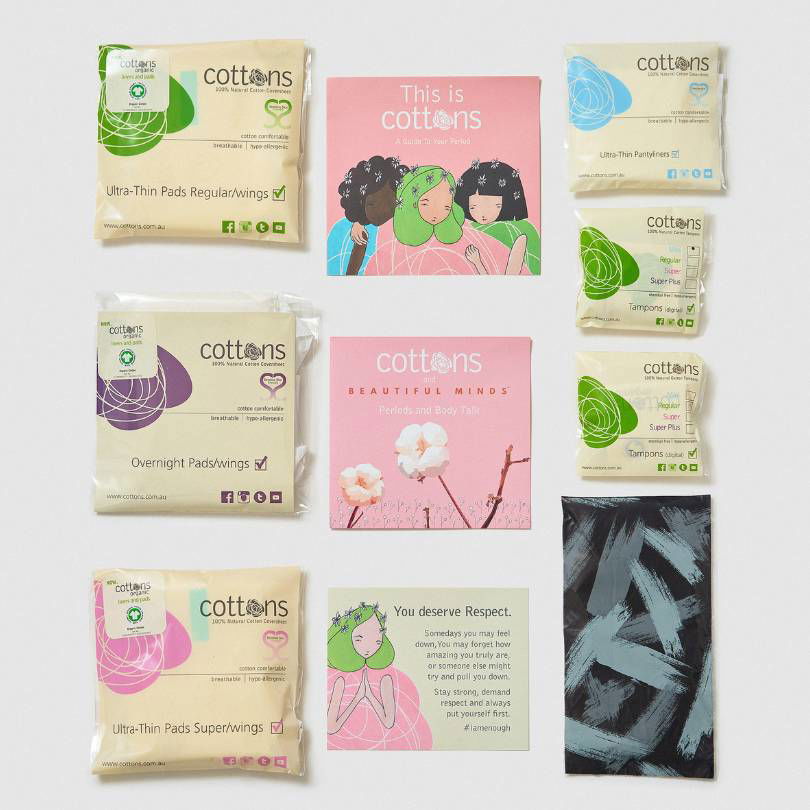A Beginner's Guide to using Pads and Tampons
There’s nothing weird, gross, or shameful about having your period. Full stop. NOT. A. THING.
Adjusting to this new phase of life might feel overwhelming at first, but trust us, being prepared and knowing what to do can make all the difference. One of the first choices you’ll make is how to manage your flow. Will it be pads? Tampons? Period underwear? Maybe you'll choose which one based on the scenario. After all, there are no lock in contracts. It's common to use one form of protection during the day and another for, say, sport or sleep, etc.
If you’ve already grabbed our first period kit, you’re off to a cracking start. Inside, you’ll find everything you need to tackle this new chapter like the boss you are (plus a handy guide to help you along the way). But if you’re here for the lowdown on pads and tampons, keep reading—we’ve broken it all down just for you.

How to Use a Pad
(Because We’re All About Keeping It Simple)
Pads are a great starting point if you’re new to periods. They’re easy to use and fuss-free, making them a go-to option for many first-timers. Here’s how to get started:
- Peel and Stick: Remove the backing paper and stick the pad to your underwear. If the pad has wings, fold them over the sides of your undies—they’ll help keep leaks in check.
- When to Change: You’ll know it’s time to switch to a new pad when it starts feeling wet, damp, or heavy in your underwear. To change it, simply peel it off and wrap it up in toilet paper.
- Disposal: Throw your used pads in the bin (never in the toilet, unless you fancy a plumbing disaster).
How to Use a Tampon
(For When You’re Ready to Level Up)
Tampons might feel a bit intimidating at first, but they’re really not that complicated. Here’s a simple step-by-step guide to help you out:
- Wash Your Hands: Before anything else! Clean hands are a must.
- Insert It: Using your finger, gently insert the tampon. The string should hang outside your body. If it feels uncomfortable, it might not be in far enough—just push it up a little more. You can do this sitting, standing, or however feels most comfortable for you.
- Wash Your Hands Again: Hygiene is key, people.
- When to Change: Give the string a gentle tug. If the tampon slides out easily, it’s ready to come out. If not, give it a bit more time (but don’t leave it in for more than 4-6 hours).
- Remove and Dispose: To remove, pull the string downward. Wrap the tampon in toilet paper and chuck it in the bin.

What to Expect During Your Period
(Spoiler: It’s Totally Normal)
Your period will usually start light, get a bit heavier, and then taper off after a few days. The colour may range from bright red to brownish—it’s all normal, so don’t freak out. It might look like a lot of blood, but it’s usually only about 2-3 tablespoons in total.
If your period seems super light and short, it could just be spotting, which is common when your hormones are doing their thing. And if something feels off or you’re worried? Chat with someone you trust or see a GP.
The Joys of PMS (Sarcasm Alert)
(AKA Why You’re Craving Chocolate and Snapping at Everyone)
PMS (premenstrual syndrome) can make its presence known before or during your period. Here’s what you might notice:
- Cramps in your lower tummy or back.
- Feeling bloated like you’ve had three helpings of pasta.
- Sore or tender boobs (ugh).
- Tummy trouble—anything from constipation to diarrhea.
- Feeling drained, moody, or like you’re on an emotional rollercoaster.
- Intense cravings for carbs, sugar, or salty snacks. (Hello, chips and chocolate!)
It’s all part of the ride, but if the symptoms are too much to handle, don’t hesitate to talk to a doctor.
Your First Period Kit Is Your New BFF
If you’re feeling nervous about your first period, our first period kit has got your back. It’s packed with the essentials you need, plus some extra goodies to make this time a little less daunting. Think of it as your period survival kit, designed to help you navigate everything from pads and tampons to those inevitable cravings.
Getting your first period is a big deal, but it doesn’t have to be a stressful one. Armed with the right tools (and a little know-how), you’ll be handling it like a pro in no time. And remember, there’s no one “right” way to manage your period—whether it’s pads, tampons, or something else entirely, the choice is yours. You’ve got this!
Ready to get started? Check out our first period kit for everything you need to feel prepared, confident, and in control.
First Period Kit
Share







